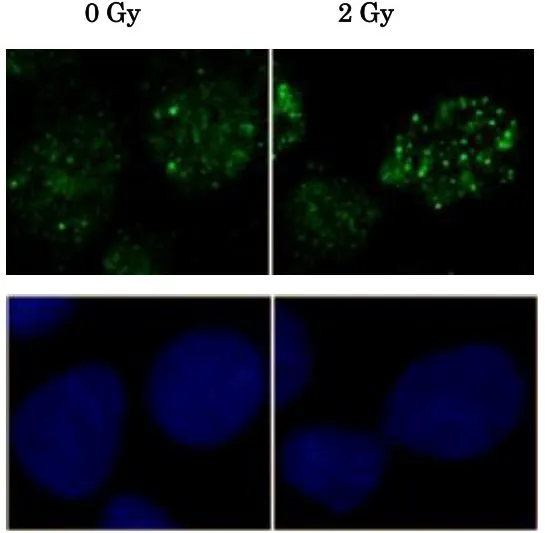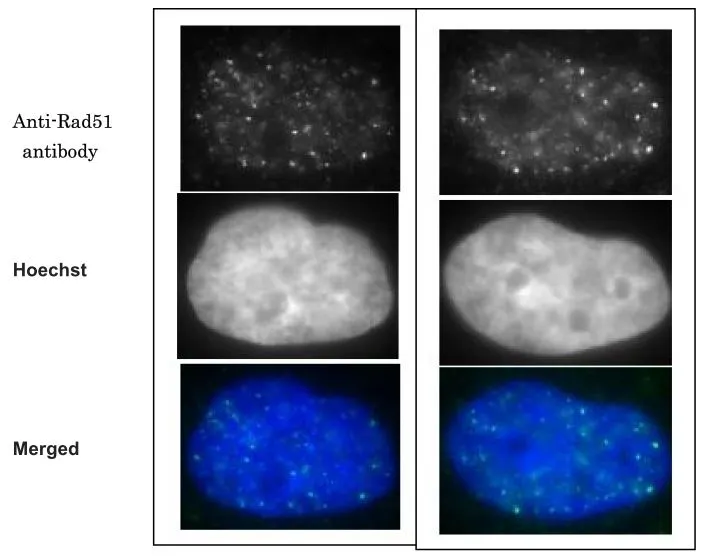Rad51 antibody [N1C2]
GTX100469
ApplicationsImmunoFluorescence, ImmunoPrecipitation, Western Blot, ImmunoCytoChemistry, ImmunoHistoChemistry, ImmunoHistoChemistry Paraffin
Product group Antibodies
TargetRAD51
Overview
- SupplierGeneTex
- Product NameRad51 antibody [N1C2]
- Delivery Days Customer9
- Application Supplier NoteWB: 1:500-1:3000. ICC/IF: 1:100-1:1000. IHC-P: 1:100-1:1000. IP: 1:100-1:500. *Optimal dilutions/concentrations should be determined by the researcher.Not tested in other applications.
- ApplicationsImmunoFluorescence, ImmunoPrecipitation, Western Blot, ImmunoCytoChemistry, ImmunoHistoChemistry, ImmunoHistoChemistry Paraffin
- CertificationResearch Use Only
- ClonalityPolyclonal
- Concentration0.14 mg/ml
- ConjugateUnconjugated
- Gene ID5888
- Target nameRAD51
- Target descriptionRAD51 recombinase
- Target synonymsBRCC5, FANCR, HRAD51, HsRad51, HsT16930, MRMV2, RAD51A, RECA, DNA repair protein RAD51 homolog 1, BRCA1/BRCA2-containing complex, subunit 5, RAD51 homolog A, RecA, E. coli, homolog of, RecA-like protein, recombination protein A
- HostRabbit
- IsotypeIgG
- Protein IDQ06609
- Protein NameDNA repair protein RAD51 homolog 1
- Scientific DescriptionThe protein encoded by this gene is a member of the RAD51 protein family. RAD51 family members are highly similar to bacterial RecA and Saccharomyces cerevisiae Rad51, and are known to be involved in the homologous recombination and repair of DNA. This protein can interact with the ssDNA-binding protein RPA and RAD52, and it is thought to play roles in homologous pairing and strand transfer of DNA. This protein is also found to interact with BRCA1 and BRCA2, which may be important for the cellular response to DNA damage. BRCA2 is shown to regulate both the intracellular localization and DNA-binding ability of this protein. Loss of these controls following BRCA2 inactivation may be a key event leading to genomic instability and tumorigenesis. Two alternatively spliced transcript variants of this gene, which encode distinct proteins, have been reported. Transcript variants utilizing alternative polyA signals exist. [provided by RefSeq]
- Storage Instruction-20°C or -80°C,2°C to 8°C
- UNSPSC12352203
References
- Wang YY, Cheng KH, Hung AC, et al. Differential impact of cytoplasmic vs. nuclear RAD51 expression on breast cancer progression and patient prognosis. Int J Oncol. 2024,64(2):pii: 12. doi: 10.3892/ijo.2023.5600.Read this paper
- Chakraborty A, Sreenivasmurthy SG, Miller W, et al. Fructose-2,6-bisphosphate restores DNA repair activity of PNKP and ameliorates neurodegenerative symptoms in Huntington's disease. bioRxiv. 2024,:pii: 2023.10.26.564220. doi: 10.1101/2023.10.26.564220.Read this paper
- Krawic C, Luczak MW, Valiente S, et al. Atypical genotoxicity of carcinogenic nickel(II): Linkage to dNTP biosynthesis, DNA-incorporated rNMPs, and impaired repair of TOP1-DNA crosslinks. J Biol Chem. 2023,299(12):105385. doi: 10.1016/j.jbc.2023.105385Read this paper
- Tsai YF, Chan LP, Chen YK, et al. RAD51 is a poor prognostic marker and a potential therapeutic target for oral squamous cell carcinoma. Cancer Cell Int. 2023,23(1):231. doi: 10.1186/s12935-023-03071-wRead this paper
- Zhou Q, Tu X, Hou X, et al. Syk-dependent alternative homologous recombination activation promotes cancer resistance to DNA targeted therapy. Res Sq. 2023,:pii: rs.3.rs-2922520. doi: 10.21203/rs.3.rs-2922520/v1.Read this paper
- Endo S, Yoshino Y, Shirota M, et al. BRCA1/ATF1-Mediated Transactivation is Involved in Resistance to PARP Inhibitors and Cisplatin. Cancer Res Commun. 2021,1(2):90-105. doi: 10.1158/2767-9764.CRC-21-0064Read this paper
- Kim H, Kim D, Choi H, et al. Deubiquitinase USP2 stabilizes the MRE11-RAD50-NBS1 complex at DNA double-strand break sites by counteracting the ubiquitination of NBS1. J Biol Chem. 2023,299(1):102752. doi: 10.1016/j.jbc.2022.102752Read this paper
- Wu DD, Dai LJ, Tan HW, et al. Transcriptional upregulation of MAPK15 by NF-κB signaling boosts the efficacy of combination therapy with cisplatin and TNF-α. iScience. 2022,25(12):105459. doi: 10.1016/j.isci.2022.105459Read this paper
- Chu YY, Chen MK, Wei Y, et al. Targeting the ALK-CDK9-Tyr19 kinase cascade sensitizes ovarian and breast tumors to PARP inhibition via destabilization of the P-TEFb complex. Nat Cancer. 2022,3(10):1211-1227. doi: 10.1038/s43018-022-00438-2Read this paper
- Zhang Y, Ou G, Ye Z, et al. RPRM negatively regulates ATM levels through its nuclear translocation on irradiation mediated by CDK4/6 and IPO11. iScience. 2022,25(10):105115. doi: 10.1016/j.isci.2022.105115Read this paper




